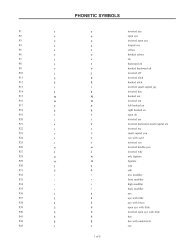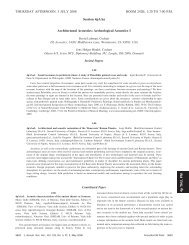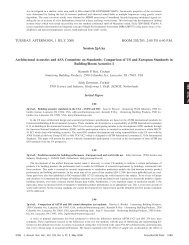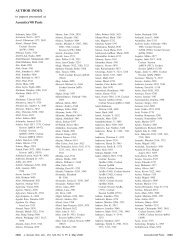Tuesday afternoon, 11 November - The Acoustical Society of America
Tuesday afternoon, 11 November - The Acoustical Society of America
Tuesday afternoon, 11 November - The Acoustical Society of America
Create successful ePaper yourself
Turn your PDF publications into a flip-book with our unique Google optimized e-Paper software.
5:05<br />
2pAA13. Predictions <strong>of</strong> sound energy flows in coupled spaces using a<br />
diffusion equation model. Yun Jing and Ning Xiang Graduate Program in<br />
Architectural Acoust., School <strong>of</strong> Architecture, Rensselaer Polytechnic Inst.,<br />
Troy, NY 12180<br />
In this work, a diffusion equation model J. Xiang, J. Acoust. Soc. Am.,<br />
123, 145–153 2008 is applied to two coupled spaces to study the time-<br />
dependent sound energy flows through the coupling area aperture. <strong>The</strong> energy<br />
feedback is found when the primary room is less reverberant than the<br />
secondary room. <strong>The</strong> Bayesian framework is applied to quantify doubleslope<br />
characteristics <strong>of</strong> sound-energy flow decays obtained from the diffusion<br />
equation numerical simulations. This work also reveals that the turning<br />
point on a double-sloped energy decay is highly correlated to the time instant<br />
when the energy flow direction flips over.<br />
TUESDAY AFTERNOON, <strong>11</strong> NOVEMBER 2008 LEGENDS 2, 1:30 TO 4:55 P.M.<br />
Session 2pAB<br />
Animal Bioacoustics: Marine Mammal Acoustics in Honor <strong>of</strong> Sam Ridgway II<br />
James J. Finneran, Chair<br />
SPAWARSYSCEN San Diego, 53560 Hull St., San Diego, CA 92152<br />
Invited Papers<br />
1:30<br />
2pAB1. Prey capture by harbor porpoises. Lee Miller Inst. <strong>of</strong> Biology, Univ. <strong>of</strong> Southern Denmark, Campusvej 55, DK-5230 Odense<br />
M., Denmark, lee@biology.sdu.dk<br />
<strong>The</strong> harbor porpoise Phocoena phocoena is a small toothed whale living mostly in coastal waters. <strong>The</strong>re are large, but unknown,<br />
numbers in the inner Danish waters. Four are in captivity at Fjord Belt Center, Kerteminde, Denmark, one <strong>of</strong> which was born there in<br />
2006. Harbor porpoises use their ultrasonic clicks as biosonar for orientation and detection <strong>of</strong> prey mostly smaller pelagic and bottom<br />
dwelling fish, and for communication. For studying wild animals, hydrophone arrays Villadsgaard et al., J. Exp. Biol. 210 2007 and<br />
acoustic time/depth tags Akamatsu et al., Deep Sea Res. 2 2007 have been used. For studying captive animals, arrays and video<br />
techniques Verfuss et al., J. Exp. Biol. 208 2005, as well as miniature acoustic-behavioral tags Deruiter et al., J. Acoust. Soc. Am<br />
123 2008, have been used. While searching for prey, harbor porpoises use clicks at long intervals 50 ms that progressively decrease<br />
when closing an object. After detecting the prey, the click interval stabilizes and then becomes progressively shorter while approaching<br />
the prey. <strong>The</strong> sequence ends in a terminal high-repetition rate buzz 500 clicks/s just before capturing the prey a video will be shown.<br />
<strong>The</strong> temporal sequence differs from that <strong>of</strong> beaked whales but is similar to that <strong>of</strong> bats.<br />
1:50<br />
2pAB2. Backscatter measurements <strong>of</strong> three species <strong>of</strong> salmon using simulated killer whale echolocation signals. Whitlow W. L. Au<br />
Hawaii Inst. <strong>of</strong> Marine Biology, Univ. <strong>of</strong> Hawaii, P.O. Box <strong>11</strong>06, Kailua, HI 96734, John K. Horne and Christopher D. Jones Univ.<br />
<strong>of</strong> Washington, Seattle, WA 98105-6698<br />
<strong>The</strong> resident ecotype <strong>of</strong> killer whales Orcinus orca in the waters <strong>of</strong> British Columbia and Washington State has a strong preference<br />
for Chinook salmon even in months when Chinook are 5%–10% <strong>of</strong> the salmon population. <strong>The</strong> foraging behavior <strong>of</strong> killer whales<br />
suggests that they rely on echolocation to detect and recognize their prey. In order to determine possible cues in echoes from salmon,<br />
a series <strong>of</strong> backscatter measurements was made at the Applied Physics Laboratory, University <strong>of</strong> Washington Facility on Lake Union,<br />
on three different salmon species using simulated killer whale echolocation signals. <strong>The</strong> fish were tied to a mon<strong>of</strong>ilament net and rotated<br />
while echoes were collected, digitized, and stored on a laptop computer. Three transducer depths were used; same depth, 22 o , and 45 o<br />
above the horizontal plane <strong>of</strong> the fish. Echoes were collected from five Chinook, three Coho, and one Sockeye salmon. Radiograph<br />
images <strong>of</strong> all the specimens were also obtained to examine the swim bladder shape and orientation. Results show that the echo structure<br />
from similar sized but different species <strong>of</strong> salmon were different and probably recognizable by foraging killer whales. <strong>The</strong> results also<br />
suggest that a broadband echo-sounder pointing downward could be used to discriminate salmon species.<br />
2:10<br />
2pAB3. Progress in clinical hearing evaluation <strong>of</strong> bottlenose dolphins (Tursiops truncatus). James J. Finneran U.S. Navy Marine<br />
Mammal Program, Space and Naval Warfare Systems Ctr., San Diego, Code 71510, 49620 Beluga Rd., San Diego, CA 92152 and<br />
Dorian S. Houser Biomimetica, Santee, CA 92071<br />
It has long been recognized that the need to train experimental subjects is a major obstacle to large scale behavioral hearing studies<br />
<strong>of</strong> marine mammals. <strong>The</strong> time and level <strong>of</strong> access required for behavioral audiometry have not only prevented hearing assessment in<br />
wild individuals but have also limited attempts to assess auditory system fitness in captive populations. Ridgway and co-workers <strong>of</strong><br />
electrophysiological methods were quick to realize that auditory evoked potential AEP measurements could be used to assess marine<br />
mammal hearing without lengthy training. Ridgway performed some <strong>of</strong> the earliest work to characterize dolphin evoked potentials and<br />
to develop fast techniques for threshold measurement. In addition to hearing assessment in larger whales not routinely kept in captivity,<br />
2482 J. Acoust. Soc. Am., Vol. 124, No. 4, Pt. 2, October 2008 156th Meeting: <strong>Acoustical</strong> <strong>Society</strong> <strong>of</strong> <strong>America</strong><br />
2482







